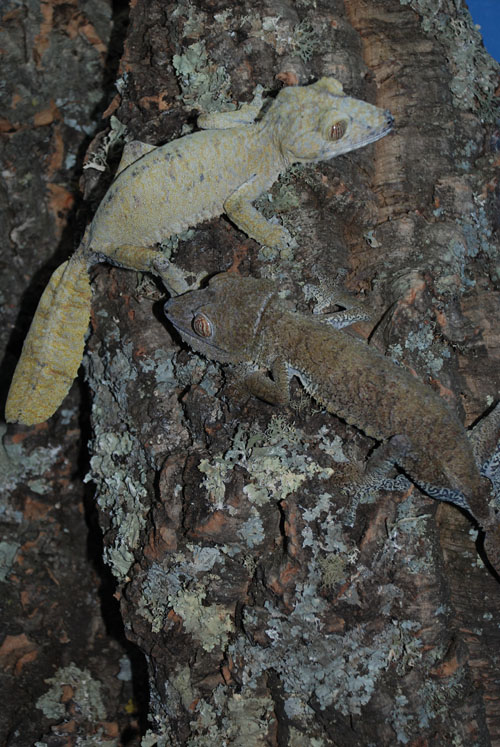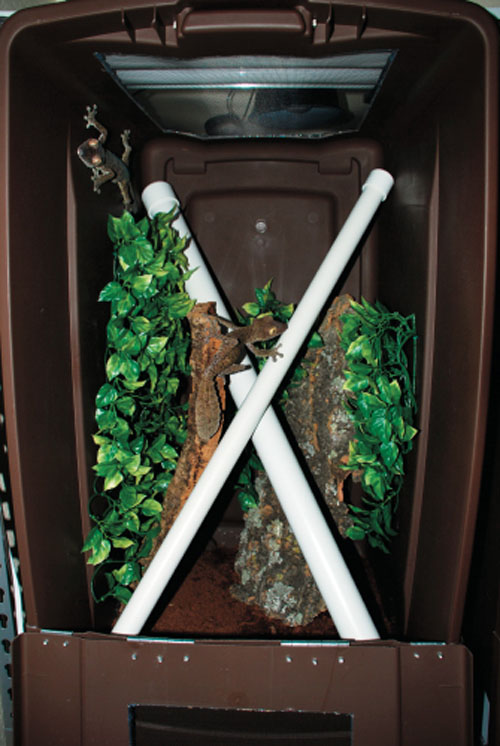Uroplatus fimbriatus has stringent care requirements
Commonly called the giant leaf-tailed gecko, Uroplatus fimbriatus was once imported into the United States by the thousands, but the number of imports is now very limited due to much-needed restrictions that protect wild populations. This is why its captive propagation is so necessary, and why this magnificent gecko should be kept only by experienced hobbyists, as its care requirements are more stringent than other popular pet geckos, such as leopard and crested geckos.

Photo credit: Erik Strait
Uroplatus fimbriatus is a large, nocturnal gecko. It is the largest of the 12 known Uroplatus species, with an average total length of approximately 11 to 11.5 inches, with a snout-to-vent length of about 7.5 to 8 inches.
Uroplatus fimbriatus is a large, nocturnal gecko. It is the largest of the 12 known Uroplatus species, with an average total length of approximately 11 to 11.5 inches, with a snout-to-vent length of about 7.5 to 8 inches. It has a relatively flattened body, large eyes due to its nocturnal lifestyle, and very muscular legs it uses to leap from tree to tree within its tropical rain forest habitat along the eastern coast of Madagascar. Individuals can most often be found in trees, normally on branches or tree trunks within 10 feet of the ground. Wild leaf-tails appear to prefer smaller trees and branches that measure about 11.5 to 6 inches in diameter. Their cryptic body shape – they're also called "fringed" leaf-tails because of this – as well as pattern and coloration provides camouflage against branches and bark, and the geckos will shimmy around a branch or tree trunk to remain outside of a perceived predator's line of vision.
Leaf-Tail Gecko Care
Set up properly, giant leaf-tailed geckos can be prolific breeders. A hatchling or juvenile can be kept in an enclosure measuring 12 inches long, 12 inches wide and 18 inches tall. Single adults can be housed in cages measuring 18 inches long, 18 inches wide and 36 inches tall, and pairs or trios should be kept in a cage measuring 24 inches long, 24 inches wide and 48 inches tall.
I use paper toweling as a substrate for all my hatchling leaf-tails, to reduce the risk of accidental ingestion and impaction. It's easy to clean, too. I provide multiple layers to create some cushion, because Uroplatus are enthusiastic feeders that may bang their snouts against the substrate while pouncing at prey items. Substrate for juvenile and adult leaf-tails is a peat moss/soil/coco-fiber mixture, but coco-fiber alone can suffice, too.
Cage decorations and cover must be included but do not overcrowd the cage. The geckos should have space to jump to and from branches and the sides of the enclosure. I provide PVC for my geckos to perch on during the day and to climb at night. It's easy to clean and readily available. I also provide natural tree branches (be sure they are free from contaminants) and keep one or two large pieces of cork bark in the cage to provide other climbing and hiding opportunities, as well as rough surfaces to aid in shedding. Plants are also needed; I use large plastic plants with large leaves.

Photo Credit: Erik Strait.
I provide PVC for my geckos to perch on during the day and to climb at night. It's easy to clean and readily available. I also provide natural tree branches (be sure they are free from contaminants) and keep one or two large pieces of cork bark in the cage to provide other climbing and hiding opportunities.
Giant leaf-tailed geckos like to be kept fairly cool. I keep the room's air temperature around 75 degrees Fahrenheit. Over the cages themselves, I use a 60-watt bulb that keeps the temperature at the top of each cage around 80 to 82 degrees. The geckos bask toward the top of the enclosure during mid day and move down to cooler locations once they reach a suitable body temperature. At night, I drop the temperature in the room to between the low 70s and high 60s.
I provide UVB lighting because even though Uroplatus are nocturnal, wild specimens do have some access to natural sunlight. My lighting schedule varies depending on the season – it's shorter during the "dry season" I use to induce breeding – but in general, I use a 12-hour-on/12-hour-off schedule.
Given the tendency of Uroplatus to dehydrate in captivity, misting and humidity are vital to their survival and breeding success. They will rarely drink out of a standing water bowl, but I provide one just in case. I mist them heavily every night, spraying cage decorations and the enclosure's sides to provide drops of water for the geckos to lick up. Misting, of course, helps maintain humidity, too.
Feed to Breed
A varied diet is crucial for leaf-tails to thrive. Every other night, I offer each adult four to six large crickets, as well as some additional insects (roaches, superworms, waxworms, etc.). To stop worms from burrowing into the substrate, I hand feed them to my geckos. During the breeding season, my females readily accept pinky mice, and these help the females to produce well-calcified eggs.
Calcium and vitamin supplements are also needed. I provide Miner-All with vitamin D3 to my geckos that are not kept under UVB, and Miner-All without D3 for the ones that are. I also dust insects with Herptivite multivitamin powder at least once a week.
Breeding the Best
When choosing breeding stock, always buy captive-bred leaf-tails, mainly because they are hardier and have better survival rates then wild-caught geckos. Only experienced keepers should consider adding wild-caught animals to a breeding colony. Not only will they require a quarantine period, they often arrive dehydrated and in rough condition. Without the proper supervision, they can quickly perish. Imports need treatment for both internal and external parasites, and because the medication can easily be overdosed, I recommend that only a veterinarian familiar with reptiles administer it. If you have no choice but to purchase wild-caught specimens, find a dealer who has had the leaf-tails for a few months, to ensure that they are eating and drinking, and that they have begun adjusting to captivity.
Breeding this magnificent species in captivity can be tricky. Keep them housed in a cage that provides a sufficient amount of room and that most closely replicates their natural habitat. For optimal breeding success, go with a breeding trio of one male and two females, or a male/female pair. Do not keep sexually mature males in the same enclosure. They will attack each other.
To initiate breeding I employ a cool-down period. Starting in September, I gradually drop the ambient temperature in my Uroplatus rooms to between 65 and 70 degrees. I also decrease misting to a lighter mist, which ensures that the geckos don't dehydrate while still simulating a dry season. I reduce the photoperiod to nine hours of light, after which any UVB lights, as well as the 60-watt overhead bulb on each enclosure, is turned off. I maintain these conditions for approximately three to four months, and then I gradually increase the ambient room temperature back to the usual 75 degrees, and slowly return misting and photoperiod to normal levels. These three variables – lowering the temperature, decreasing misting and changing the photoperiod from 12 hours to nine – have increased my success rate in producing leaf-tail offspring.
The geckos do not typically mate during the cool-down period; it is a time for them to rest from the previous breeding season. Mating activity generally resumes when I return the temperature, misting and light schedules to normal levels. Eggs may be laid from January until the beginning of September, prior to the next cool-down period. The majority of eggs are laid from March through August.
Gravid females will typically lay one or two eggs under the substrate approximately three or four weeks after a successful mating. Watch for signs of digging. It is crucial to extract the eggs carefully for artificial incubation. Doing so allows you to keep temperatures and humidity stable. It's safer for the eggs, too, and can prevent them from being overturned, oversaturated with misting water, and possibly damaged by feeder insects left in the adults' enclosure.
The egg (or two eggs) is incubated inside an incubator, in a plastic deli cup with a 1:1 ratio of perlite to water. I place eggs on cut pieces of foam to avoid direct contact with the incubation medium. This soft, 1-inch-thick, green foam can be purchased at any craft store; it is often used for chair cushions. I cut it into 2-inch-square pieces, and then scoop a divot out of the top of each piece. The egg nestles inside the divot so it doesn't rotate or come in contact with the moistened perlite.
If incubated at 78 degrees, eggs generally hatch after 90 to 120 days. I have found 78 degrees to yield the most successful hatchings. As mentioned, the hatchling(s) can be kept in an enclosure measuring 12 inches long, 12 inches wide and 18 inches tall. They usually will not eat for the first few days while they absorb their remaining yolk. After a few days, I offer small crickets. I always watch new hatchlings to make sure they eat, and won't leave them to eat on their own until they seem to have gotten the hang of it. I typically offer a hatchling three or four crickets every night. Once a hatchling giant leaf-tail reaches juvenile status, at a length of about 5 or 6 inches, I offer food every other day and continue to do so from that point on.
Well Worth the Effort
I have worked with Uroplatus for more than a decade, and after considerable trial and error, I now know what works best when trying to keep and breed them. Captive-bred giant leaf-tailed geckos are still fairly hard to find, and those that do become available are often snapped up without ever being listed on any dealer price lists. As mentioned, the captive propagation of Uroplatus fimbriatus is vital to keep this magnificent species in private collections, as well as to help reduce the number of leaf-tails taken from the wild. I hope that this article motivates you to keep and breed these amazing geckos for yourself.



